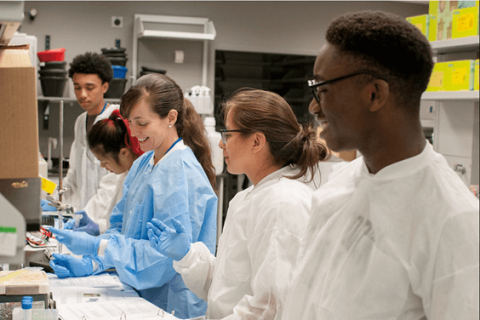
Credit: Office of Intramural Training & Education, National Institutes of Health
A diverse workforce is an essential component of any successful enterprise that thrives on innovation. However, merely being aware of the need for diversity, or just having an organizational Diversity, Equity, and Inclusion (DEI) policy, is not enough to reap the benefits of a diverse workforce. Efforts to promote and sustain diversity must be systematically implemented, evaluated using rigorous scientific techniques, driven by data, and shaped by a broad array of voices in positions of authority. Leveraging the full power of our diverse biomedical workforce to face today’s public health and societal challenges requires supporting and sustaining individuals from groups currently underrepresented in the STEM workforce [1].
Diversity Drives Innovation
In their 2015 paper, former NIH Chief Officer of Scientific Workforce Diversity Dr. Hannah Valantine and NIH Director Dr. Francis Collins describe what we know about the Science of Diversity. We know that a diverse workforce not only brings to the table (or the lab) a range of backgrounds and cultures, but this type of workforce also represents an array of lived experiences, perspectives, thinking styles, and abilities. The notable benefits of diversity in driving innovation can be seen in the business world, for example, where innovation-focused companies with female representation in leadership are more successful than those with less gender diversity.
Success Is A Byproduct of Diversity
Research on the science of diversity further shows that diverse teams generate higher quality products, success for individuals as well as teams, and are more likely to meet the needs of the populations they serve. As with innovation, these outcomes provide measurable, tangible reasons why striving for a diverse workforce can ultimately drive organizational success. For example:
- Journal articles published by gender-diverse groups may be more frequently cited and articles by author groups with diverse ethnic origins may be published in higher impact journals. Both outcomes are proxy measures for quality and overall research impact.
- In clinical settings, diverse healthcare professionals tend to deliver improved and culturally informed care for underserved groups.
- In academic settings, racial diversity may result in educational benefits for all students, even those who don’t directly engage in cross-cultural activities.
Leadership Must Drive Organizational Culture Change
Innovation. Quality. Success. It would be easy to stop there and posit that policies aimed at improving diversity will inherently result in positive outcomes for our biomedical research enterprise. However, introducing individuals from diverse backgrounds into the workforce is not enough; leadership must be willing to transform their organizational cultures to truly support and sustain individuals throughout their career trajectories.
These transformational principles include:
1) Empowering individuals from diverse and underrepresented backgrounds to be authentic to the breadth of their cultural experiences and background at work without pressure to conform to the behaviors or opinions of others in the workplace.
2) Ensuring that individuals from diverse and underrepresented backgrounds conceive of themselves as scientists and feel included in all facets of the scientific research community.
3) Providing individuals from diverse and underrepresented backgrounds with opportunities to flourish throughout their career trajectories via thoughtful mentorship, sponsorship, fair recruitment and evaluation, and equitable implementation of organizational policies.
4) Ensuring that the workplace climate does not preclude individuals from bringing their ideas, experiences, and abilities to the table by addressing harassment, including sexual harassment, and workplace incivility, which we know disproportionately affects women, individuals with disabilities, and sexual and gender minorities at various institutions and organizations, including the NIH.
Since 2014, our Office’s work has focused not only on how diversity can benefit the scientific enterprise, but also what science tells us are the most effective strategies to support and retain a diverse workforce. We have an array of programs and resources aimed at addressing these transformational principles—for example, novel cohort hiring programs and disseminating research on why human behaviors such as stereotyping affect biomedical research. Our NIH Diversity Catalysts bring together individuals committed to diversity across NIH Institutes and Centers, a confluence of diverse disciplines and perspectives that Team Science research suggests may be a driving force behind success.
Parting Thought
I invite you to spend some time reading and sharing the resources we have compiled with the aim of advancing scientific workforce diversity in a data-driven way. I also invite you to consider my parting thought: Just as we often cannot predict how basic science discoveries will influence the long-term trajectory of our human existence, we cannot fully anticipate the amazing potential of a truly diverse workforce until we achieve it.
Marie A. Bernard, M.D.
________________________________
[1] Individuals underrepresented in the biomedical workforce refers to women, Blacks or African Americans, Hispanics or Latinos, American Indians or Alaska Natives, Native Hawaiians and other Pacific Islanders, individuals with disabilities, sexual and gender minorities, and individuals from disadvantaged backgrounds

